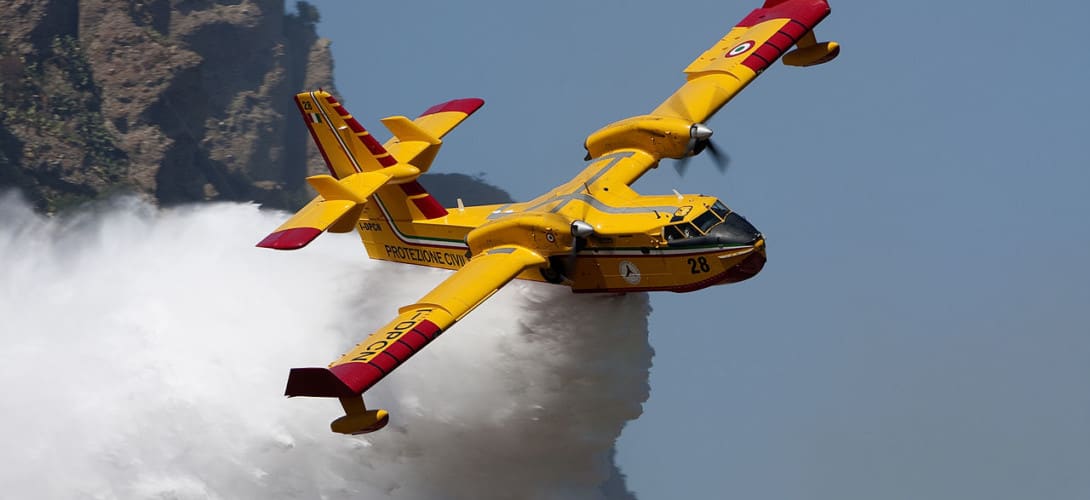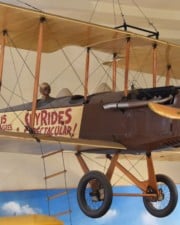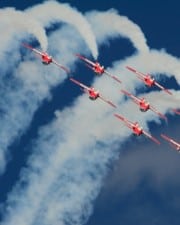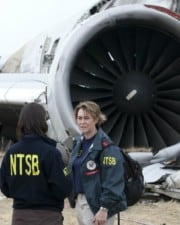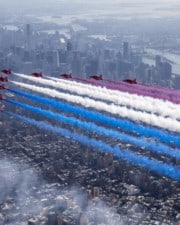Aerial firefighting plays a crucial role in helping ground crews combat the most dangerous and violent wildfires. On more than one occasion, it has been the difference between successfully containing a wildfire and letting it endanger huge swathes of the population.
Though indispensable now, throughout the history of aerial firefighting, it hasn’t always been so. Once an idea that was laughed at, aerial firefighters had to fight tooth-and-nail to prove they could do their job without endangering even more people and still provide ground crews with the aerial support they’d always craved.
In this article, I’ll discuss not only the operational history of aerial firefighting, but its origins as an idea itself, the technological advancements that have shaped it and the steps towards the future aerial firefighting operators are making right now.
Origins
The idea of aerial firefighting is likely as old as the concept of aviation itself. Though theorized for centuries, the first practical ideas for such operations date back to 1930.
The previous year, German aviator Friedrich Karl von Koenig-Warthausen was flying over the mountains of California as a part of his attempt to be the first to perform a solo circumnavigation by air (which he ultimately accomplished).
Flying over the Santa Lucia Mountains, which were at that time experiencing one of the worst wildfires recorded up until that time, he noticed his aircraft flew considerably higher than the smoke the fires created, allowing him to fly over the fire with his vision unobstructed.
Upon completing his aerial circumnavigation, Koenig-Warthausen began to theorize how a modified bomber could have its bomb bay modified to hold water instead of bombs and how it could fly over a fire and drop its payload, aiding firefighters on the ground.
He published his theory in his book Wings Around The World, which detailed his aerial circumnavigation, and the various theories for the future of aviation he’d come up with whilst doing it.
A Beginning
When Koenig-Warthausen’s book was published, many of his theories were greeted with a mixture of mockery and outright rejection. His theory about fighting fires from the air, struck a nerve in the Western US.
Over the next decade, aircraft engineers in the Western US conducted numerous experiments dropping different volumes of water – and even early flame retardant chemicals – from different altitudes on different types of fires.
For the most part, however, these experiments were not done by the growing aircraft manufacturers of the interwar period on the West Coast, but by small manufacturers and even individual pilots.
This meant that aerial firefighting was often not taken seriously by the aviation industry or general public.
WWII, however, changed all that. The war saw cities on both sides be devastated by intense bombing, made worse by the introduction of incendiary explosives (also known as firebombs), which saw entire cities engulfed in flames.
With fire departments overwhelmed and often unable to get to entire parts of the cities to get to the fire, plans were drawn up to have these fires doused from the skies.
Older and obsolete bombers and cargo aircraft – many from the prewar years – were retrofitted for aerial firefighting missions and saw limited action during the war, mostly in Germany and Japan nearing the very end of the war.
Adoption
The end of the war, however, did not end the need for aerial firefighting aircraft. Though they only saw limited action during the war, their effectiveness brought the idea to the mainstream.
Coupled with the market flooding with surplus wartime aircraft, including many bombers and cargo aircraft, saw huge numbers of A-26 Invader, DC-4 and Martin Mars aircraft be modified for aerial firefighting use.
These newly modified aircraft saw use not only in the US, but also parts of Europe, Asia and Oceania experiencing large bush and/or wildfires.
By the 1950s, it became clear that the modified surplus WWII aircraft being used for aerial firefighting missions were becoming obsolete in their new role. To that end, new aircraft began to be phased in to replace them.
This second generation, consisted mostly of now-obsolete piston airliners like the Douglas DC-6 and DC-7, entered service as aerial firefighters just as their service lives came to an end with the introduction of the first jet airliners.

Where the first generation had been modified as one-off projects by independent groups of engineers, the second generation were modified by professional aircraft modification companies, making these aircraft more uniform in how they were built and used.
Expansion
In many ways, the 1960s and 1970s were the beginning of aerial firefighting as a seriously taken form of aviation.
It marked a period where aircraft manufacturers – namely Canada’s premier aircraft manufacturer, Canadair – began to design purpose-built aerial firefighting aircraft like the CL-215, in stark contrast to the repurposed retrofits used in the preceding decades.
It also marked the beginning of helitack – a combination of the words “helicopter” and “attack” – with helicopters being used alongside fixed wing firefighting aircraft due to their increased maneuverability.
The adoption of both helicopters and purpose-built aerial firefighting fixed-wing aircraft allowed more suitable communications systems to be installed. This allowed for more and more efficient coordination with ground forces, helping to save many more lives. Much of this technology is still used today.
It was also during this period where aerial firefighting became more popular internationally. Before this, aerial firefighting had mostly been confined to the Western US, Canada and the Australian Outback.
On the back of the devastation brought about in Vietnam by Agent Orange, aerial firefighting began to be used in Asia.
Similarly, pro-Western regimes in South America and Africa were provided with aerial firefighting aircraft by Western governments as a part of humanitarian and Cold War-era development policies.
Interestingly, its success in the West helped it to become popular on the other side of the Iron Curtain too.
Here, surplus military aircraft, many from the prewar and wartime eras, were retrofitted to be used as aerial firefighters in the parts of the Eastern Bloc most susceptible to wildfires, namely the grasslands of the Ukrainian SSR and the Steppes of the Kazakh SSR.
Smokejumping
The concept of using aircraft to drop firefighters into areas that firetrucks can’t reach has been around since at least the 1930s. And whilst some fairly successful attempts were made to do this before, the 1960s was when this concept, known as smokejumping, began to be used more seriously.
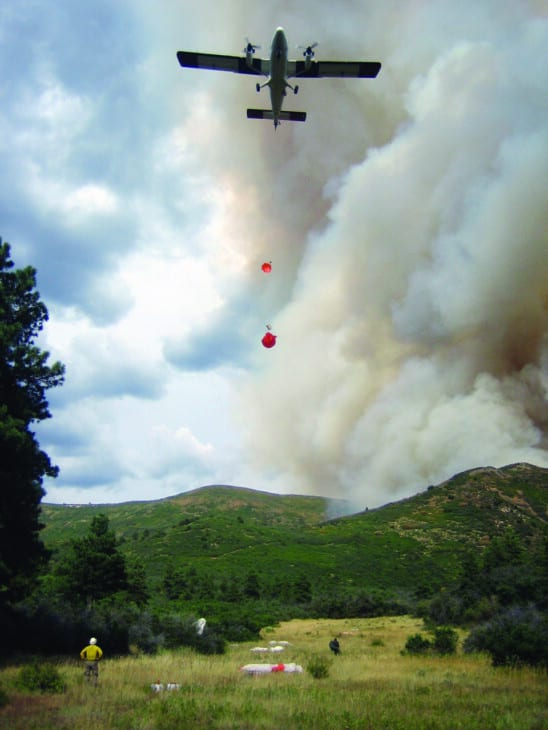
Spurred on by the return of experienced paratroopers from the Vietnam War – many of whom were familiar with deploying near burning forests and jungles – as well as advancements in Self-Contained Breathing Apparatus (SCBA) technology, smokejumping became a vital part of any aerial firefighting operation.
Where previous decades’ smokejumping attempts had seen smokejumpers using the same tactics used by regular firefighters, the 1960’s saw the development and implementation of smokejumper-specific tactics, increasing their effectiveness whilst reducing the risk to the smokejumpers.
In addition, more stringent requirements for potential smokejumping candidates were introduced, ensuring that all smokejumping teams had only the most qualified candidates, further increasing their effectiveness and safety on-the-job.
Technological Advancements
With aerial firefighting now a vital part of any wildfire fighting mission, the 1980s and early 1990s marked an era of unprecedented technological advancements that were purpose-built for aerial firefighting missions of all shapes and sizes.
The first major development was that of helibuckets, which could be used by helicopters to collect and drop water and other firefighting chemicals onto the fire.
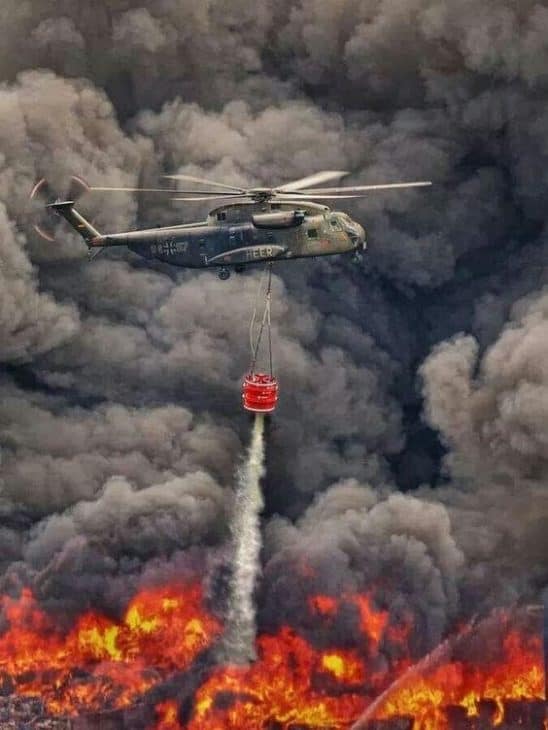
By making many of these helibuckets universal in many cases (assuming their weight is compatible with the helicopter’s MTOW), this allowed more helicopters to be used for aerial firefighting missions, regardless of whether they’d been specially-modified for such missions.
Up until this point, different aircraft had been using water or fire retardant chemicals to fight the fires they were up against. The 1980s and early 1990s, however, saw the formulation of literally hundreds of new fire retardant chemicals.
Many of these chemicals were formulated for specific types of fires and different fire intensities, giving aerial firefighters far better tools to fight the specific fire they’re dealing with, allowing them to do so quicker and with less risk to themselves and their aircraft.
The early 1980s saw the adoption of radio detection finding (RDF) technology, which allowed them to locate – and ultimately reach – fires quicker and with more accuracy. In turn, this allowed them to conserve valuable fuel and ensure their payload was as effective as possible.
By the late 1980s, going right the way through to the early 1990s, RDF technology began to be replaced by satellite-based GPS, which was even more accurate than radio-based RDF.
This means that payloads were rarely, if ever, wasted, and aerial firefighting aircraft can respond to changing flying conditions brought about by the fire they’re fighting in real-time, further increasing their effectiveness, whilst reducing unnecessary wear-and-tear to the aircraft.
In addition, the 1980s also saw the beginning of the computer age. Algorithms that predicted fire behavior began to be used in aerial firefighting operations, allowing aerial firefighting aircraft to contain the spread of the fire by targeting where it would get worse, whilst also targeting the worst parts of the fire.
Modernization
The late 1990s, 2000s and 2010s were difficult for the aerial firefighting industry. Beginning in the late 1990s, government organizations tasked with handling aerial firefighting operations saw their budgets slashed in both nominal and real terms.
This placed a huge strain on their ability to continue their operations. To cope, many departments had to downsize, often forcing their most experienced people into early retirement, or best into the private sector.
Globally, many operators were also stuck with aging fleets no longer fit for the missions they needed to fly. With maintenance costs rising, many operators cannibalized their own aircraft to save money.
Recognizing this – as well as their own precarious financial states – aircraft manufacturers pulled back from producing purpose-built aerial firefighting aircraft, instead opting to create aerial firefighting variants of existing cargo models, at a fraction of the cost.
This allowed for huge cargo aircraft, such as the Ilyushin Il-76, De Havilland Canada Q400 and Antonov An-32, to become the Il-76TD, Q400MT and An-32 Firekiller respectively.
In addition, the 2000s in particular saw the modification of huge aircraft – namely the DC-10 and 747 – into aerial firefighting aircraft, allowing one aircraft to replace several, reducing costs considerably without compromising operational capacity.
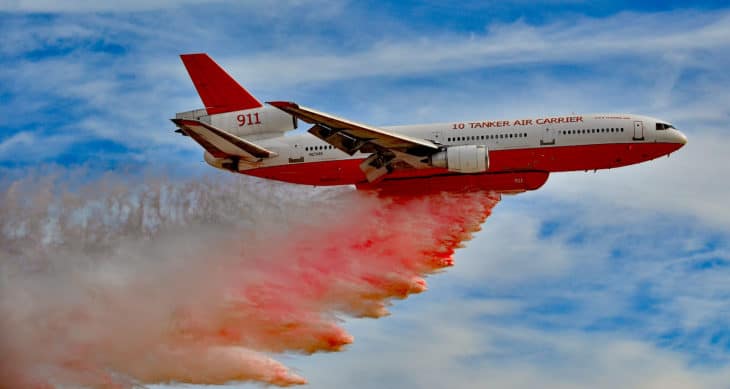
Though these new aircraft helped alleviate some of the financial stress in the short-term, by the 2010s, these government departments had begun to award contracts to private aerial firefighting companies in lieu of performing these flights themselves.
With this, however, came the widespread adoption of night vision drop technology, allowing for 24 hour operations in an area of aviation that had long been relegated to daytime-only flights.
Environmentally-Friendly Shift
The 2010s have been marked by growing environmental awareness. Companies, governments and the general public have begun to place a greater emphasis on them becoming more environmentally friendly. Aviation was no different.
In the early 2010s, a number of scientific research papers were published looking at the effect retardant chemicals commonly used by aerial firefighting aircraft had on the environment.
What these papers revealed shocked the industry into action.
The papers revealed that the chemicals damaged ecosystems, aquatic life, and soil quality. Some even linked it to potentially causing various respiratory diseases in humans who were near the drop site (though these claims were heavily disputed).
Due to the media coverage, public outcry and regulatory scrutiny this brought, new fire retardant chemicals were introduced throughout the 2010s, replacing the environmentally-unfriendly chemicals of the 20th century.
Often, these new fire retardant chemicals were reformulations of existing chemicals, which removed the potentially carcinogenic chemicals. In addition, these chemicals were made to be biodegradable, further reducing their environmental impact.
During the late 2010s, there was a shift towards producing carbon neutral fire retardant chemicals, however, most of these have yet to hit the market or gain certification for use.
2020s
If the 2010s were marked by a shift towards being eco-friendly, the 2020s have been marked by environmental disaster after environmental disaster.
Bushfires and wildfires – the kinds of fires usually fought by aerial firefighting aircraft – have not only become more commonplace, but have become far more intense.
2020, 2021, 2022 and 2023 have seen some of the most devastating wildfires in world history, each of which have pushed the bounds of aerial firefighting technology. And they’re expected to only get worse.
Similarly, there has been more investment in satellite technology by aerial firefighting operators, allowing them to detect fires earlier and monitor fires currently being tackled in real time in a way never done before.
From an aircraft engineering point-of-view, the 2020s has also been marked by an interest in producing modular air tankers, allowing each module to be purpose-configured for each mission and easily swapped between different aircraft, allowing for greater uniformity across aerial firefighting operations.
This has all allowed aerial firefighters to tackle more vicious fires in a much shorter time than in previous decades, while delivering a larger payload in a more efficient manner.
Drones
Aside from seeing a huge increase in the need for aerial firefighting aircraft, the 2020s has also seen the introduction of firefighting drones to complement existing fleets of fixed and rotary wing aerial firefighting aircraft.
Due to the fact that the technology is still very much in its infancy, aerial firefighting drones have yet to enter service in any real capacity. Instead, most are still in the prototype phase.
Of those currently in service, most are in Asia, where drone regulations are less strict than in the West, where they’ve seen considerable success. Most of these deliver relatively small payloads (around 2 kg/4.4 lbs) but are designed to make multiple drops on a single charge.
There’s currently much research going on in both the East and West to extend the flight times and payload capacities of all types of drones (including firefighting drones) to make them more effective as both individual drones, or as a part of a swarm.
By the end of the decade, it is expected that regulations will have modernized and drone technology advanced, making UAVs a common, and indispensable part of any aerial firefighting fleet.
Whilst there has been much attention focused on the use of drones to fight the fires themselves, drones have seen significant use in a reconnaissance capacity, helping to monitor and coordinate aerial and ground efforts as well as helping to identify humans trapped by, or in the vicinity of, the fire.
Related Posts
